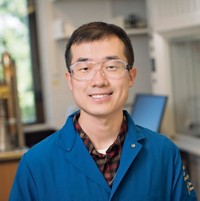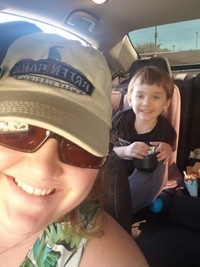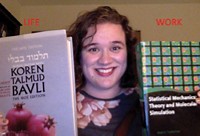Advertisement
Grab your lab coat. Let's get started
Welcome!
Welcome!
Create an account below to get 6 C&EN articles per month, receive newsletters and more - all free.
It seems this is your first time logging in online. Please enter the following information to continue.
As an ACS member you automatically get access to this site. All we need is few more details to create your reading experience.
Not you? Sign in with a different account.
Not you? Sign in with a different account.
ERROR 1
ERROR 1
ERROR 2
ERROR 2
ERROR 2
ERROR 2
ERROR 2
Password and Confirm password must match.
If you have an ACS member number, please enter it here so we can link this account to your membership. (optional)
ERROR 2
ACS values your privacy. By submitting your information, you are gaining access to C&EN and subscribing to our weekly newsletter. We use the information you provide to make your reading experience better, and we will never sell your data to third party members.
Business
New Chemistry Professors Share Their Experiences
Recently ushered into academia, four chemists share the joys and tribulations of their new roles
by Susan J. Ainsworth
September 8, 2014
| A version of this story appeared in
Volume 92, Issue 36
Especially in today’s extremely competitive job market, landing a first-time faculty position can be an exhilarating experience. However, for new professors that excitement may quickly give way to anxiety as they juggle multiple tasks, including taking on teaching responsibilities, building a research group from scratch, and struggling to get a barren lab up and running.
To get a snapshot of the experience, C&EN spoke with four chemists who have recently moved into assistant professor roles. Here we share their stories, which detail how they are tackling problems and building efficiencies while savoring the excitement and freedom that comes with captaining their own research ship.
Kara J. Stowers, Assistant Professor of Inorganic Chemistry, Brigham Young University, Provo, Utah

Growing up in Utah, and the first in her family to attend college, Kara J. Stowers says she never would have imagined she would end up as an assistant professor of chemistry at Brigham Young University (BYU). “I was fortunate to have really good mentors who helped me realize I had the potential and the ability and the skill set to do this job and be good at it,” she says.
Arriving at BYU just last month, Stowers plans to pursue her passion for catalysis research that spans inorganic, organic, and physical chemistry. She aims to form an interdisciplinary research group to synthesize non-precious-metal catalysts and modify them with different additives to determine how to maximize reactivity with carbon dioxide. She hopes to obtain carboxylic acid products to use as precursors to polymers, she says. She will also investigate the catalysts in ultrahigh vacuum using surface science techniques to identify reaction mechanisms at the catalyst surface. That information will ultimately help the group design new, greener catalysts; optimize reactions; and improve catalyst efficiency, she adds.
Because BYU gives its new chemistry professors a reprieve from teaching duties for the first semester, Stowers is able to focus all of her energy and resources on setting up her lab. For now, she is busy shopping around for the best deals on everything from round-bottom flasks to a combined gas chromatograph/mass spectrometer for her lab, using funds from the start-up package she received from BYU.
To procure additional funding for her research, she plans to dedicate a signficant portion of the first semester at BYU to writing and submitting grants to the American Chemical Society’s Petroleum Research Fund, the National Science Foundation, and the American Association for the Advancement of Science, she says.
At the same time, she is trying to attract talented undergrad and grad students to work in her lab. Toward that end, she has posted advertisements in common areas and information boards and has e-mailed incoming graduate students in an attempt to meet with them individually on campus.
As she anticipates the challenges she will face in her new role, Stowers does not expect to encounter any that are specific to being a woman, even in a male-dominated department where there are fewer women research professors than teaching professors. Coming up through the ranks in the labs of graduate adviser Melanie S. Sanford at the University of Michigan, Ann Arbor, and postdoc adviser Cynthia M. Friend at Harvard University, both of which included many women, she has not yet experienced gender discrimination and isn’t particularly worried about it, she says. “I feel I have wise people to turn to for advice if anything comes up.”
Stowers says she is excited to be joining what she senses is a “collaborative and cohesive” department that is currently attracting a lot of new, young professors to succeed those who are retiring. During the interview process, “it just struck me as a fun and dynamic place to be.
“I am enthusiastic about having the freedom to independently go after ideas that I am really passionate about and that I have synthesized as a result of my past research experiences,” she says. “I am excited and a little nervous to see if these ideas will work, and if not, I am anxious to find out what happens instead.
“The field of inorganic chemistry is very muddied right now; it’s a mix of organometallic reactions and bioinorganic chemistry and environmental chemistry,” she says. “But I find that to be exciting because by being in this field right now, you get to help define it.”
She says she is thrilled to be able to spread her contagious interest and curiosity to students. “I am looking forward to being in a situation where I can do what my mentors did for me: really help people explore their dreams and figure out what they want to do in life.”
Abraham Badu-Tawiah, Assistant Professor of Chemistry, Ohio State University, Columbus

As a child in Ghana, Abraham Badu-Tawiah walked barefoot to primary school, carrying the pair of shoes he needed for admittance to class so they would not wear out. That experience was the first of many challenges he faced in taking up a career in chemistry—a subject he began studying only because it was one of the few available to him in his home country.
After moving to the U.S. and completing a Ph.D. at Purdue University under R. Graham Cooks and a postdoc at Harvard under George M. Whitesides, Badu-Tawiah moved into a coveted role as assistant professor in the chemistry department at Ohio State University in early July.
Already, he is teaching two graduate courses this semester, which began on Aug. 27. At the same time, he has been busy setting up his lab and finding additional students to join the high school student and two undergrads he recruited via his website.
In his research, Badu-Tawiah is focused primarily on simplifying the interpretation of mass spectrometry data to make the method more accessible and useful for MS nonexperts, including pathologists, immunologists, and neuroscientists. His proposed methodology relies on the development of novel chemical probes that enable MS analysis of proteins, antigens, DNA, and other disease biomarkers under ambient conditions.
Setting up his first academic lab has been “scary,” he admits. “Coming from Harvard, where I had everything, to this stark new lab, where I have zero, has been a daunting experience,” he adds. Much of his time has been spent identifying the items he needs to order and shopping around to get the best prices in an effort to stretch his limited budget over the next three years.
He is also working on grant applications to submit to NSF and the National Institutes of Health.
As he transitions into his new role, one of the biggest challenges Badu-Tawiah has faced has been making time for his wife and two children, ages three and one and a half. To juggle it all, he wakes up at 4 AM each morning and tries to get home from the lab by 7 PM to spend time with his kids before they go to bed. Setting up their new home is a work in progress, he says.
Even so, he is much more energized than discouraged in his new position, which he describes as “a dream come true.” No stranger to roadblocks and setbacks, Badu-Tawiah aims to “take baby steps, one step at a time, while working hard and working efficiently,” he says, “and remaining vigilant in the details.”
Yogesh (Yogi) Surendranath, Assistant Professor of Chemistry, Massachusetts Institute of Technology

Although Yogesh (Yogi) Surendranath has only been in his role as assistant professor of chemistry at Massachusetts Institute of Technology for a little more than a year, he seems a natural for the position, having honed procedures and a perspective characteristic of a more seasoned academic.
Born in Bangalore, India, Surendranath immigrated to the U.S. at age three with his family and grew up around his father’s organic chemistry lab at Kent State University in Ohio. He cultivated an interest in science at a young age, but it was his work in the organometallic chemistry laboratory of W. Dean Harman at the University of Virginia that sparked his passion for the field of inorganic chemistry.
After earning a Ph.D. in inorganic chemistry in 2011 at MIT under Daniel G. Nocera, he landed a postdoc as a Miller Fellow at the University of California, Berkeley, under A. Paul Alivisatos. He then moved into his current position at MIT in July of last year.
The Surendranath lab is focused on addressing global challenges in chemical catalysis, energy storage and utilization, and environmental stewardship. “Fundamental and technological advances in each of these areas require new methods for controlling the selectivity and efficiency of reactions at solid-liquid interfaces,” he says. The group’s strategy emphasizes the bottom-up, molecular-level engineering of functional inorganic interfaces with a current focus on electrochemical energy conversion.
Even while diving into this complex, multifaceted research area, Surendranath says he did not find his first year on the MIT faculty to be particularly stressful. Initially, he faced some minor, mostly logistical challenges as he purchased and installed equipment, he says. However, he had the aid of a postdoc and three students, whom he was able to recruit to start with him on day one. Amazingly, they helped him make his lab operational in only about a month.
Still, his transition into the new role was not entirely seamless. “I had not expected that I would have to make such a rapid transition from being someone who would go into the lab every single day to do an experiment to someone who more often than not was writing papers or grants on the computer,” he says. “Although it was a sudden transition, it was a transition I have enjoyed quite a bit.” One plus, he says, is that he is surrounded by several other junior faculty members, who help him maintain a positive perspective and feel less isolated.
A self-proclaimed “efficiency freak,” Surendranath has wasted no time instituting some helpful tools for his group. For example, he set up a wiki, a Web application that enables members of the group to post the content of their lab notebooks and instrument operation guides, as well as tips, safety procedures, and details about group events. Through this tool, “even when I am away from the lab, I am able to stay very connected and track the intellectual growth of the group.”
In another move, he has developed an exercise that encourages his students to use the skills he learned in policy debate in high school to help them think critically in the lab. Specifically, he chooses a scientific paper and asks those in his group to take sides, either affirming the publication or refuting it. In the process, he teaches students how to construct arguments, present good proposals, and speak eloquently.
Overall, he believes his job has brought him much more joy than challenge. “I didn’t know it would be so enjoyable to watch students and postdocs grow in their experimental acumen, their command of the literature, and their ability to stand on their own two feet,” he says.
“I still pinch myself every day because I can’t believe I am fortunate enough to have this job—and I do think it is the best job in the world.”
P. Matthew Joyner, Assistant Professor of Biochemistry, Pepperdine University, Malibu, Calif.

It was while working on an undergraduate project with his professor, Julie Marshall, at Lubbock Christian University in Texas that Matthew Joyner discovered he had a passion for research. So when it came time to choose a career path after earning a Ph.D. at the University of Oklahoma, working in academia was definitely something he considered. After all, it was more or less the family business, given that his father is a math professor.
However, he wasn’t hooked on the idea until he interviewed at Pepperdine University. “I was so impressed by the people and students that I knew it was the right place for me,” he says. The campus location, overlooking the beaches of Malibu, Calif., and the sparkling Pacific Ocean, certainly didn’t hinder his decision.
Since joining Pepperdine as an assistant professor in January 2011, Joyner has split his time equally between teaching and conducting research. Like most pretenure science faculty members at the small, private university, he has been responsible for teaching two classes and one lab each semester, he says. Tenured faculty carry a heavier load.
Advertisement
At the same time, Joyner has been building a lab from scratch, tapping into what he describes as “ample start-up funds” from Pepperdine. A generous package has enabled him to hit the ground running and postpone seeking external funding for his research until now.
In his research, Joyner is investigating the chemistry of native Southern California plants that are used for medicinal purposes. “I consider the uses of these plants as antibacterial or anti-inflammatory treatments as a starting point for selecting bioassays,” he says. “Then I use traditional methods such as bioassay-guided fractionation to identify active compounds from the plants.”
His goal is to provide chemical data that may support or contradict the purported efficacy of the traditional uses of the plants he is studying.
Because Pepperdine does not have graduate science programs, Joyner recruits undergrads to support him in the lab, primarily during their summer break. Training students to use equipment and learn various techniques has been the biggest challenge he has faced in establishing his lab, he says.
Launching the lab “didn’t seem that daunting at first,” he says. “Because of the excitement of starting something new, everything seemed possible.” However, “as projects hit roadblocks and students rotated in and out of the lab, it became apparent that completing projects and publishing our work was going to be difficult.”
To streamline these efforts, Joyner found he needed to take a more hands-on approach, working more directly with his students and performing the more difficult procedures himself, he says. “I’ve learned that it is important to spend time demonstrating your technique and approach, showing students how to do things correctly, and defining expectations.”
Despite the challenges of his job, Joyner loves that it allows him to “learn new things all the time,” he says. “In particular, I really enjoy interacting with colleagues outside my own field.”
He also prizes the breadth of his day-to-day activities—something he didn’t expect as an assistant professor. “One day I will spend all day with people: teaching, tutoring, and training. The next day I may have to be a recluse, locked in my office reading, writing, and planning experiments and lectures. Each day is different and requires different skills, which I enjoy.”






Join the conversation
Contact the reporter
Submit a Letter to the Editor for publication
Engage with us on Twitter